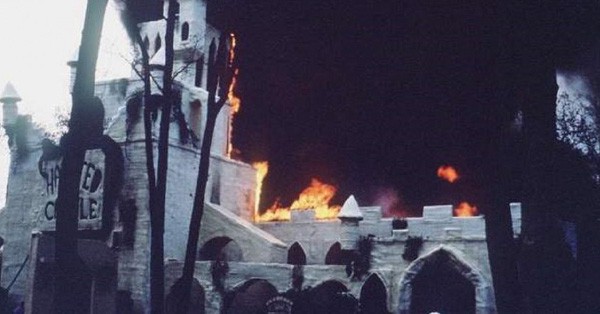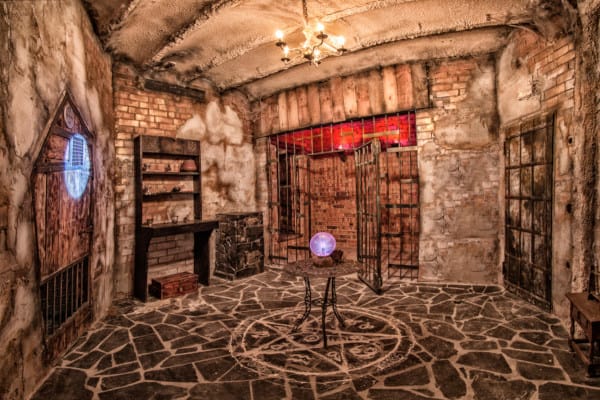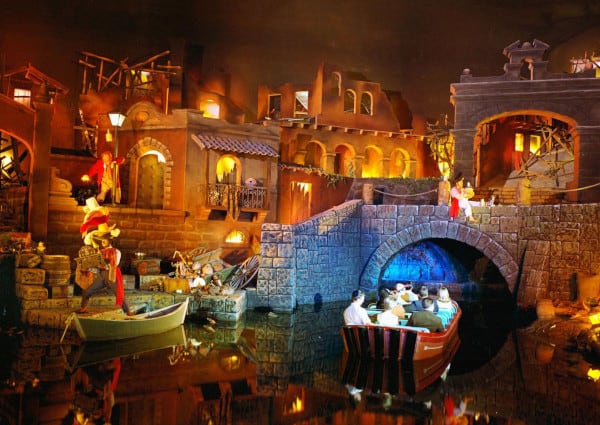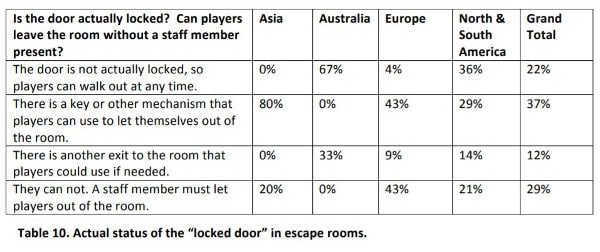A tragedy causes NFPA and ICC code to lock down escape room fire safety regulations
A birthday celebration turned tragic earlier this year when a fire broke out in an escape room facility in northern Poland, killing five 15-year-old girls and injuring the sole adult employee on the premises.
The girls were racing to solve the escape room’s puzzles when a leaky gas container inside a heater reportedly sparked the fire. Firefighters also blamed substandard security procedures for the tragedy: the blaze broke out in the reception area, blocking an employee from evacuating the trapped teenagers. Even worse, when the girls tried to escape themselves, they realized they had been locked inside and their only means of opening the door was with the help of the attendant—or by finishing the game.
Autopsies showed the girls died of carbon monoxide inhalation and they were the first known escape room-related deaths worldwide. The owner of the business was charged with “deliberately creating the danger of a fire” and “unintentionally causing the death of people in a fire” by failing to provide egress routes that would have allowed the girls to flee, according to media reports. Even the windows in the escape room had been covered with makeshift walls.
With a captivating combination of faux high stakes, quality time with friends, a chance to flaunt puzzle-solving skills, and a guaranteed photo op, escape rooms are a global trend. But the tragedy in Poland is prompting U.S. regulators to take a harder look at the safety of the concept.
In this blog, we examine fire safety concerns inherent to the booming escape room industry. We also explain proposed changes to the 2021 editions of NFPA 101: Life Safety Code and the International Code Council’s (ICC) International Building Code (IBC) that are aimed at keeping participants safe.
In the market for fire protection? Feel free to browse our selection of fire protection equipment, including commercial and residential sprinkler heads, installation tools, fire extinguishers, heavy-duty head guards that protect sprinklers from accidental damage, Shutguns that quickly stop accidental sprinkler discharges, and so much more.

Unlocking America’s obsession with escape rooms
Since the first escape room brought a popular video game to life in Japan in 2007, there’s been no escaping the escape-room industry. In 2014, there were 22 escape rooms in the U.S. Five years later, there are more than 2,300. The growth is amazing, and regulators are scrambling to keep up.
Escape rooms sell an experience—an escape that is both literal and metaphorical for the handful of friends/colleagues/strangers “trapped” together. For a fee, participants are given the chance to collaboratively puzzle through a series of brain-busting challenges to win their freedom. The clock is ticking: most escape rooms give participants about 60 adrenaline-filled minutes to unlock the door. Inherent to the fun is a story that helps explain why you’re solving puzzles with a countdown clock, whether it’s a medieval mystery, a futuristic adventure, or escaping from a serial killer.
Escape rooms have become a new staple of corporate team-building, a unique way to celebrate events, and just a fun way to geek out on a Saturday night. Red Bull runs an Escape Room World Championship. Pop culture is so saturated with escape rooms that Columbia Pictures released an “Escape Room” horror flick earlier this year and has already announced plans for a sequel in 2020.
But the Polish tragedy focused sharp attention on the wisdom of a game designed to trap people behind locked doors. The fire safety implications are clear: history is littered with tales of tragic fires where people died because they were locked in a building or their means of egress were otherwise compromised. Suddenly, news organizations from “Inside Edition” in the U.S. to the Canadian Broadcasting Corp. were demanding to know, “Are escape rooms safe?”
After the fire, Poland’s interior minister ordered fire safety inspections at more than 1,000 escape rooms and 26 were shut down amidst safety concerns, The New York Times reports. After only three days of inspections, more than 1,100 basic safety code violations were uncovered, roughly 400 of which involved issues with emergency exits.
Most American escape rooms don’t lock people in a room with no way to manually open the door from the inside. But even so, NFPA and ICC task forces created after the Polish fire agreed that new rules were needed to shore up life safety. For the first time ever, proposed language aims to focus special attention on escape rooms in the 2021 edition of NFPA 101 and the IBC model code.
Special amusement buildings present unique fire safety hazards
While escape rooms are generally deemed safe by the people who design, operate, and even regulate them, confusion often swirls around what it really means for them to be code-compliant. For instance, while the intent of code makers is for escape rooms to largely fall under the umbrella of “special amusement buildings,” most don’t neatly fit within the nearly identical, current definitions in NFPA or IBC.
From the 2018 edition of NFPA 101
3.3.37.9 Special Amusement Building. A building that is temporary, permanent, or mobile and contains a device or system that conveys passengers or provides a walkway along, around, or over a course in any direction as a form of amusement arranged so that the egress path is not readily apparent due to visual or audio distractions or an intentionally confounded egress path, or is not readily available due to the mode of conveyance through the building or structure.
From the 2018 edition of IBC
SPECIAL AMUSEMENT BUILDING. A special amusement building is any temporary or permanent building or portion thereof that is occupied for amusement, entertainment or educational purposes and that contains a device or system that conveys passengers or provides a walkway along, around or over a course in any direction so arranged that the means of egress path is not readily apparent due to visual or audio distractions or is intentionally confounded or is not readily available because of the nature of the attraction or mode of conveyance through the building or structure.
Special amusement buildings typically cover structures where people are conveyed through an attraction by a mechanical device like Disney World’s “Pirates of the Caribbean” ride or walk through a maze-like structure such as a haunted house or laser tag arena. These buildings present unique fire hazards, with exits purposefully hard to find to add to the attraction’s thrills and disorienting special effects like strobe lights, mirrors, dim lights, and theatrical fog that make it even more challenging to get out.
Regulations for special amusement buildings were added to the 1988 edition of NFPA’s Life Safety Code after a horrific fire in the “Haunted Castle” at New Jersey’s Six Flags Great Adventure Park claimed the lives of eight teenagers in 1984. Without smoke alarms to provide early warning or fire sprinklers to stop flames from spreading—and fast egress routes impossible to determine—it took less than four minutes for the fire to flashover with tragic results.

IBC requirements for special amusement buildings are found in Section 411 of Chapter 4, “Special Detailed Requirements Based on Use and Occupancy.” In general, the IBC requires that these structures have:
- An automatic fire detection system such as smoke detectors.
- A fire alarm system.
- A fire sprinkler system with an approved temporary water supply for temporary attractions. Automatic sprinklers are not required if the total floor area of a temporary special amusement building is less than 1,000 square feet and the travel distance from any point to an exit is less than 50 feet.
- An emergency voice communication system that’s audible throughout the entire building.
- Exit signs and lighting, as well as directional path markings that become visible in an emergency in buildings where mirrors, mazes, or other designs are used to disguise exit routes. The activation of automatic fire detection or sprinkler systems must cause these markings to illuminate.
- Class A interior finishes, which are the least flammable.
IBC’s requirements apply to all special amusement buildings except structures with open-air construction, which stops smoke from gathering inside. Additional stipulations for other fire protection elements such as the number and type of fire extinguishers that are needed come down to the structure’s occupant load.
IBC instructs special amusement buildings with occupancy loads of 50 or more to also follow regulations for the appropriate Group A Assembly occupancy. Special amusement buildings with occupancy loads of 49 or less must adhere to Group B Business occupancy requirements after meeting the mandates of special amusement buildings.
NFPA regulations for special amusement buildings are found in Chapter 12 (New Assembly Occupancies) and Chapter 13 (Existing Assembly Occupancies) of NFPA 101. Once again, they are nearly identical to IBC code with a few notable exceptions:
- NFPA 101 (4.8.1) indicates that a special amusement building must comply with all special amusement building requirements and the provisions for assembly occupancies regardless of occupant load. The only exception is a multilevel play structure 10 feet or less in height, with aggregate horizontal projections that don’t exceed 160 square feet.
- 4.8.4 specifically requires an approved automatic smoke detection system for special amusement buildings that operate with reduced lighting.
- 4.8.6 requires the activation of automatic sprinklers, other suppression systems, or smoke detectors (that incorporate verification or cross-zoning to mitigate false alarms) to automatically illuminate the means of egress and terminate any conflicting sounds or visuals that might impact people’s ability to escape a fire.
- 4.8.7.2 adds requirements for floor proximity exit signs, meaning the bottom of some exit signage must be mounted no less than 6 inches from the floor and no more than 18 inches above it (this is explained in 7.10.1.6).
Watch this episode of “Learn Something New” by NFPA Journal to learn more about special amusement buildings and how NFPA code takes extra steps to protect them from fire and other life safety hazards:
Classifying escape rooms: special amusement buildings—or something else?
But while the regulations may seem clear, here’s where the confusion comes in: Escape rooms are obviously designed for amusement and the nature of the attraction prevents exits from being readily available. But escape rooms lack other components that would make classifying them as special amusement buildings a no-brainer:
There are no means of mechanical conveyance and rarely are egress routes intentionally confounded. Most also don’t include visual or audio distractions like low lighting or pulsating strobe lights.
Special amusement buildings warrant stringent means of fire and life safety protection. But many jurisdictions zero in on the low occupant load of most escape rooms and lump them into a less restrictive business occupancy, often enabling them to avoid extensive requirements for fire sprinklers or smoke detectors.
The constantly changing nature of escape rooms can also present a unique hazard. These businesses must offer new and rotating attractions to keep people returning for more games. So, while initial room designs might have complied with fire codes when the Certificate of Occupancy was issued, NFPA Journal states that new themes might unknowingly create violations that put participants at risk.
NFPA Journal also asserts that some escape room operators fail to brief participants or even employees on emergency-action procedures. Others derive a false sense of security from the idea that the rooms are constantly monitored, believing attendants will easily spot early signs of an emergency and help players escape. Unfortunately, the Polish tragedy proved that such protection isn’t enough to keep people safe.
Further complicating matters, many escape room operators also misunderstand how to utilize fire safety systems to ensure escape rooms are code compliant. NFPA 101 (7.2.1.1.3.2) prevents people from being locked “beyond their control,” except in very specific circumstances like correctional facilities and healthcare occupancies such as psychiatric wards.

NFPA Journal notes that many escape rooms have an electromagnetic button that can open the egress door off to the side—a setup that, while well-intentioned, is not compliant with NFPA or IBC codes. A fundamental tenet of the Life Safety Code is that egress should not require special knowledge, tools, or effort. And precious minutes can tick by while people fumble to locate a release mechanism near the door during emergency conditions when smoke or darkness can make it impossible to find. Unless sensor locks are used, model codes require the release for electromagnetically locked egress doors to be mounted on door hardware.
From the 2018 edition of NFPA 101
7.2.1.5.6 Door Hardware Release of Electrically Locked Egress Door Assemblies. Door assemblies in the means of egress shall be permitted to be equipped with approved electrical locking systems released by the operation of door hardware provided that all of the following conditions are met:
(1) The hardware for egress-side occupant release of the electrical lock is affixed to the door leaf.
(2) The hardware has an obvious method of operation that is readily operated in the direction of egress under all lighting conditions.
(3) The hardware is capable of being operated with one hand in the direction of egress.
(4) Operation of the hardware directly interrupts the power supply to the electric lock and unlocks the door assembly in the direction of egress.
(5)* Loss of power to the listed releasing hardware automatically electrically unlocks the door assembly in the direction of egress.
(6) Hardware for new installations is listed in accordance with ANSI/UL 294, Standard for Access Control System Units.
7.2.1.6.2 does allow an emergency override button to be installed next to the door as part of a fail-safe for electromagnetic locks released by sensors that detect approaching occupants. Sensor locks are also required to automatically unlock when the building’s fire alarm or fire sprinkler systems activate. But this type of lock usually isn’t always considered a feasible solution in an escape room because it will unlock whenever someone approaches the door.

Without national guidance, AHJs struggle with escape room fire safety regulations
Authorities Having Jurisdiction (AHJs) have the final say when it comes to escape room approvals, and their involvement through the process of building and maintaining these businesses is critical to achieving life safety. But many lack the expertise to create escape room regulations on their own. And without national guidance specific to escape rooms, some are granting permits that fall outside the model codes.
For instance, the city of Portland, OR granted an appeal to allow an escape room operated inside a building with a business occupancy to place an emergency override button for an electromagnetic lock beside the egress door—as long as emergency lighting with back-up power was installed to help participants find it. The space also did not have a fire sprinkler system or fire alarm.
“I’ve done [an escape room] once, and it’s kind of fun,” Gregory Harrington, NFPA staff liaison to NFPA 101 told NFPA Journal. “But if they’re not done correctly, they can be dangerous. It’s a concern, and we need to get the word out to AHJs that they need to be cautious about how they’re permitting these things.”
Of the nearly 200 global escape room operations surveyed by a professor of game design and development at Wilfrid Laurier University in Canada in 2015, 30 percent said they lock players inside with no way of letting themselves out. Thirty-seven percent give players a way to exit the room in an emergency, although the method doesn’t always comply with NFPA and IBC codes.
Twenty percent of escape rooms never lock the door so participants can leave at any time but generally, the game ends if the door is opened. And 12 percent lock the main door but provide another exit that players can use if needed.

New NFPA, IBC editions attempt to clear up confusion over escape room fire regulations
Code professionals hope the release of the 2021 editions of NFPA 101 and the IBC will make escape room regulations clearer. The rules will become law in jurisdictions that adopt versions of the new editions, or at least offer guidance to shape local policies.
NFPA 101: Life Safety Code
The first draft of the 2021 edition of the Life Safety Code broadens the definition of special amusement buildings to include uses for entertainment or educational purposes, which better incorporate escape rooms.
Proposed changes to the 2021 edition of NFPA 101
3.3.37.9 Special Amusement Building. A building or portion thereof that is temporary, permanent, or mobile and contains a device or ride system that conveys passengers or provides a walkway along, around, or over a course in any direction as a form of amusement, entertainment, or education and arranged so that the egress path is not readily apparent due to visual or audio distractions or an intentionally confounded egress path, or is not readily available due to the mode of conveyance through the building or structure.
The 2021 draft also adds language to the corresponding annex section aimed at helping AHJs determine whether an escape room should be classified as a special amusement building and forced to adhere to the stringent fire-safety requirements that accompany it.
Proposed changes to the 2021 edition of NFPA 101
A.3.3.37.9 Other occupancies might also fall into the classification of special amusement building if the conditions described in the definition apply. Escape rooms are an example of where such conditions might exist. It is incumbent on the authority having jurisdiction to inquire if the conditions in the escape room meet the definition of a special amusement building. Where such conditions exist, escape rooms should be classified as special amusement buildings. Where such conditions do not exist, escape rooms might be classified as another occupancy, such as business.
The proposed code also emphasizes to AHJs that spaces don’t need to meet a minimum occupant load threshold to be classified as a special amusement building. The second draft of the 2021 edition of NFPA 101 is due to be posted in January.
Proposed changes to the 2021 edition of NFPA 101
A.3.3.37.9 It is important for the authority having jurisdiction to recognize that the Code requires an occupancy to be classified as a special amusement building if the conditions in the space meet the definition of special amusement building, regardless of the occupant load of the space.

International Building Code
Pending changes from the International Code Council are even more extensive—and have already been approved as submitted for adoption in the 2021 edition of IBC. The code adds a definition for “puzzle rooms” to Section 411 that leaves no doubt as to whether escape rooms should be classified as special amusement areas:
Pending changes to the 2021 edition of IBC
PUZZLE ROOM. A puzzle room is a type of special amusement area in which occupants are encouraged to solve a challenge to escape from a room or series of rooms.
The new code further updates the special amusement building requirements to acknowledge that escape rooms may only comprise part of a building, changing all references from “special amusement building” to “special amusement area.” It also restructures the definition to make escape rooms a more obvious fit.
Pending changes to the 2021 edition of IBC
SPECIAL AMUSEMENT AREA. A special amusement area is any temporary or permanent building or portion thereof that is occupied for amusement, entertainment or educational purposes and is arranged in a manner that:
-
Makes the means of egress path not readily apparent due to visual or audio distractions.
-
Intentionally confounds identification of the means of egress path.
-
Otherwise makes the means of egress path not readily available because of the nature of the attraction or mode of conveyance through the building or structure.
The new code also recognizes the increased risks that escape rooms and other special amusement areas pose to occupants by strengthening requirements for fire safety protections. For instance, it replaces a general “automatic fire detection” requirement with a specific mandate for smoke detectors.
Pending changes to the 2021 edition of IBC
411.3 Fire alarm system. Buildings containing special amusement areas shall be equipped with an automatic smoke detection system in accordance with 907.2.12.
Egress from escape rooms is also specifically addressed for the first time in the revised code, with clear instructions about how doors need to unlock in an emergency.
Pending changes to the 2021 edition of IBC
411.5 Puzzle room exiting. Puzzle room exiting shall comply with one of the following:
1. Exiting in accordance with Chapter 10.
2. An alternative design approved by the building official.
3. Exit shall be open and readily available upon activation by the automatic fire alarm system, automatic sprinkler system, and a manual control at a constantly attended location.

New regulations may up costs but improve escape room fire safety
The new code doesn’t address every fire safety concern that surrounds escape rooms. For instance, many weave potentially unusual wiring throughout the room to create effects that enhance the experience. A careful review of electrical codes and regular inspection are critical to maintaining safe occupancy.
Some escape room operators also protest the cost of installing fire protection systems required by a new special amusement area classification—an expense that NFPA Journal concedes could put some smaller operations out of business. But as the popularity of escape rooms continues to explode, code professionals are eager to minimize risks. The most alarming thing people discover when an escape room door closes should be scary props and haunting backstories.
In the market for fire protection? Feel free to browse our selection of sprinkler system components and accessories, including commercial and residential sprinkler heads, installation tools, fire extinguishers, heavy-duty head guards that protect sprinklers from accidental damage, Shutguns that quickly stop accidental sprinkler discharges, and so much more.
For more information about QRFS products, call us at +1 (888) 361-6662 or email support@qrfs.com.
This blog was originally posted at blog.qrfs.com. Check us out at Facebook.com/QuickResponseFireSupply or on Twitter @QuickResponseFS.


